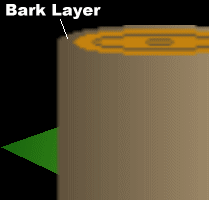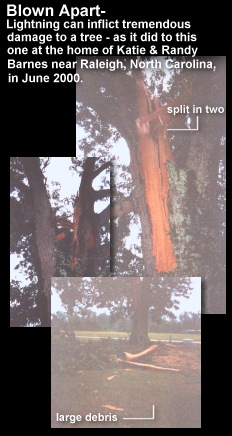Lightning Strikes to Trees
|
In September of 2025, my work is generating the most income it ever has in my career. Yet, I'm being forced to shut down my successul operation, against my will, due to one cause alone: 95% of that revenue is being stolen by piracy and copyright infringement. I've lost more than $1 million to copyright infringement in the last 15 years, and it's finally brought an end to my professional storm chasing operation. Do not be misled by the lies of infringers, anti-copyright activists and organized piracy cartels. This page is a detailed, evidenced account of my battle I had to undertake to just barely stay in business, and eventually could not overcome. It's a problem faced by all of my colleagues and most other creators in the field. |
It's a proven fact - standing under a tree is one of the most dangerous places to be in a storm. And for a good reason - trees protrude from the earth's surface, making them frequent victims of direct lightning strikes.
Electricity seeks the path of least resistance, and the moisture (sap and water) inside a tree is a much better conductor than air. The result: a tree provides a preferred path for lightning to reach ground.
Interesting things happen when lightning strikes a tree. Some trees escape completely unharmed by a direct hit, while others sustain moderate to heavy damage. Death of the tree is common in the latter instance.
Generally, lightning will do at least one of the following three things when it decides to victimize a tree:
Scarring, No Damage, and/or Complete Destruction.
How can you prevent lightning from damaging your favorite tree? Read about lightning Protection & Prevention for trees.
SCARRED
In most trees, the area just under the bark layer contains moisture in the form of sap and water. And since water is a better electrical conductor than wood, lightning striking a tree tends to travel just underneath the bark.
The explosive expansion of the lightning's return stroke will literally blast off the bark, and sometimes some
of the wood, along the length of the lightning channel. The result is a visible scar along the trunk
of the tree (watch animation below).
The image at right shows two strips (front and back views) of bark blown off of a tree by lightning. Click on the image for a larger view.

Often, the core of the lightning channel will carve a half-inch wide groove in the wood in the middle of the scar. If the lightning flash consisted of more than one return stroke, there may be two or more of these grooves in the scar. The image shown under the menu bar on the top-left side of this page shows a scar with two grooves.
Unfortunately, tree specialists say that there's not much that can be done for a tree that has lost a significant amount of bark. "Your tree may survive for a while," says Helen Southall of West Virginia Tree Expert and Nursery Co. in Ripley. "But eventually nature will take its toll on the tree."
Unlike skin on humans, bark can't be grafted or transplanted to repair the injury. "With a gash of removed bark, a tree won't be able to withstand dry spells or freezing winters," says Southall. "The injury also leaves the tree exposed and defenseless against disease and parasite infestation."
 There is, however, a way to protect your trees before the lightning strikes. There is, however, a way to protect your trees before the lightning strikes.
View trees with lightning scars in the Tree Damage Gallery.
COMPLETE DESTRUCTION
In some trees, especially those with dying or rotting areas in the trunk, the predominant moisture may be concentrated deep in the core of the tree. In this case the lightning, seeking the well-conductive moisture path, will travel through the center of the tree with devastating results. The powerful, explosive return stroke(s) will blow the
trunk apart like a stick of dynamite- sending large branches flying, splitting the trunk in two, and/or reducing large parts of the tree to splinters.
ESCAPING UNHARMED
If heavy rain has soaked the outside of the tree, a lightning strike may
flash over the outside of the bark, leaving little or no damage.
Make your own observations
Take a walk around your neighborhood or a local park or cemetery and
see if you can find a tree with lightning damage.
 About the Author: Dan Robinson has been a storm chaser, photographer and cameraman for 34 years. His career has involved traveling around the country covering the most extreme weather on the planet including tornadoes, hurricanes, lightning, floods and winter storms. Dan has been extensively published in newspapers, magazines, web articles and more, and has both supplied footage for and appeared in numerous television productions and newscasts. He has also been involved in the research community, providing material for published scientific journal papers on tornadoes and lightning. |
GO: Home | Storm Chase Logs | Photography | Extreme Weather Library | Stock Footage | Blog
Featured Weather Library Article:
|